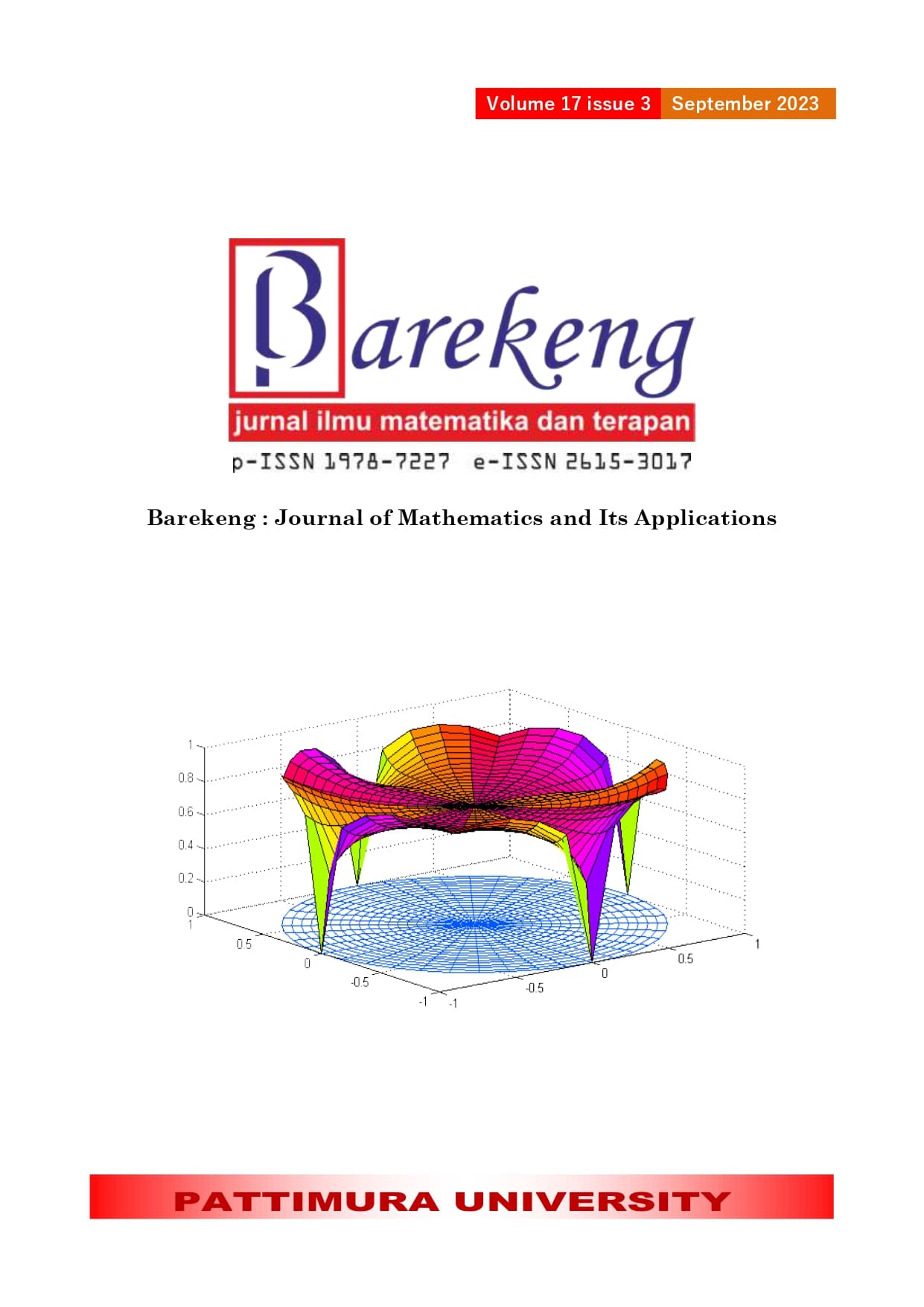PROJECTION OF THE INFLATION RATE IN PANGKALPINANG CITY USING THE AUTOREGRESSIVE MOVING AVERAGE (ARMA)
Abstract
Inflation is one of the variables in the macro economy that can affect people's welfare and is defined as a complex phenomenon due to general and continuous price increases. This study aims to project the inflation rate in Pangkalpinang City, Bangka Belitung Islands Province in the period of October, November, and December of 2022. The historical inflation data used in this study is presented in a monthly period from January 2004 ends in October 2022 and January 2023 obtained from the publication of the Central Statistics Agency (BPS) of the Bangka Belitung Islands Province. The process projection is done using the Autoregressive Integrated Moving Average (ARIMA) model after passing the model fitting process first. The projection results obtained using historical inflation data show that the ARIMA model that is suitable for the projection process is the ARMA model (4,4) with the best RMSE value of 1.21 and MAE of 0.89. Through the results of this projection, it is also obtained that the percentage value of the inflation rate in Pangkalpinang City has decreased by 0.03% in the period of October 2022 and has increased in the period of November by 0.05%, then the inflation rate in Pangkalpinang City will again decline in the period of December 2022. by 0.3% and an increase of 0.33% in January 2023.
Downloads
References
Nugroho Arif Sudibyo, Ardymulya Iswardani, Arif Wicaksono Septyanto, and Tyan Ganang Wicaksono, “Prediksi Inflasi Di Indonesia Menggunakan Metode Moving Average, Single Exponential Smoothing Dan Double Exponential Smoothing,” J. Lebesgue J. Ilm. Pendidik. Mat. Mat. dan Stat., vol. 1, no. 2, pp. 123–129, 2020, doi: 10.46306/lb.v1i2.25.
A. Pebrianti, A. S. Utami, A. T. Putri, and A. Fitriana, “Proyeksi Laju Inflasi di Indonesia Dengan Metode ARIMA ( Autoregressive Integrated Moving Average ) Proyeksi Laju Inflasi di Indonesia Dengan Metode ARIMA ( Autoregressive Integrated Moving Average ),” ResearchGate, no. July, pp. 1–13, 2021.
A. Wahyuni, “Prediksi Nilai Inflasi Post Covid 19 di Indonesia,” Indones. J. Islam. Econ. Financ., vol. 2, no. 1, pp. 57–65, 2022, doi: 10.37680/ijief.v2i1.1606.
S. Blandina, A. Noor Fitrian, and W. Septiyani, “Strategi Menghindarkan Indonesia dari Ancaman Resesi Ekonomi di Masa Pandemi,” Efektor, vol. 7, no. 2, pp. 181–190, 2020, doi: 10.29407/e.v7i2.15043.
S. Darmastuti, M. Juned, F. A. Susanto, and R. N. Al-Husin, “COVID-19 dan Kebijakan dalam Menyikapi Resesi Ekonomi: Studi Kasus Indonesia, Filipina, dan Singapura,” J. Madani Ilmu Pengetahuan, Teknol. dan Hum., vol. 4, no. 1, pp. 70–86, 2021, doi: 10.33753/madani.v4i1.148.
A. A. Hamzah, ““Rencana Umum Energi Daerah,” vol. 1, pp. 7–8, 2020.
R. Nurhamidah, “ANALISIS PERBANDINGAN INFLASI PERKOTAAN DAN PEDESAAN PADA GABUNGAN DUA KOTA DI PROVINSI KEPULAUAN BANGKA BELITUNG Rahma,” J. Empower. Community Educ., vol. 2, no. December 2021, pp. 423–443, 2022.
K. Adam, E. Gautier, S. Santoro, and H. Weber, “The case for a positive euro area inflation target: Evidence from france, germany and italy,” J. Monet. Econ., no. xxxx, pp. 1–14, 2022, doi: 10.1016/j.jmoneco.2022.09.002.
W. S, “Prediksi Inflasi Indonesia Memakai Model ARIMA dan Artificial Neural Network,” J. Tata Kelola dan Kerangka Kerja Teknol. Inf., vol. 5, no. 1, 2019, doi: 10.34010/jtk3ti.v5i1.2297.
D. Y. Dalimunthe and H. Aldila, “Projection and Analysis of National Energy Consumption Levels on Indonesia’s Economic Growth Rate through Exponential Smoothing Approach,” IOP Conf. Ser. Earth Environ. Sci., vol. 353, no. 1, 2019, doi: 10.1088/1755-1315/353/1/012056.
D. Valeriani, D. Y. Dalimunthe, E. Fitriyanti, and I. Sulistiana, “The Iinfluence Of Triple Track Strategies In Developing Tourism Against Economic Growth Province Bangka Belitung Island,” 2019, doi: 10.2991/icoma-18.2019.54.
M. Farid, “Krisis Politik dan Resesi Ekonomi Hong Kong (2019) dalam Perspektif Konstelasi Global dan Potensi Dampaknya Bagi Indonesia,” J. Kaji. Lemhannas RI, vol. 7, no. 4, pp. 35–50, 2019, [Online]. Available: https://prosiding.lemhannas.go.id/index.php/jkl/article/view/110/31.
Tarno, Subanar, D. Rosadi, and Suhartono, “New procedure for determining order of subset Autoregressive Integrated Moving Average (ARIMA) based on over-fitting concept,” ICSSBE 2012 - Proceedings, 2012 Int. Conf. Stat. Sci. Bus. Eng. "Empowering Decis. Mak. with Stat. Sci., no. June 2016, pp. 639–643, 2012, doi: 10.1109/ICSSBE.2012.6396643.
R. Susanti and A. R. Adji, “Analisis Peramalan Ihsg Dengan Time Series Modeling Arima ( Analysis Of Indonesia Composite Index ( Ihsg ) Forecasting With Arima Time Series Modeling ),” J. Manaj. Kewirausahaan, vol. 17, no. 01, pp. 97–106, 2020, [Online]. Available: http://ejurnal.stieipwija.ac.id/index.php/jmk/article/view/393/0.
A. Asrirawan, S. U. Permata, and M. I. Fauzan, “Pendekatan Univariate Time Series Modelling untuk Prediksi Kuartalan Pertumbuhan Ekonomi Indonesia Pasca Vaksinasi COVID-19,” Jambura J. Math., vol. 4, no. 1, pp. 86–103, 2022, doi: 10.34312/jjom.v4i1.11717.
F. Nur Hadiansyah, “Prediksi Harga Cabai dengan Menggunakan pemodelan Time Series ARIMA,” Indones. J. Comput., vol. 2, no. 1, p. 71, 2017, doi: 10.21108/indojc.2017.2.1.144.
D. Chicco, M. J. Warrens, and G. Jurman, “The coefficient of determination R-squared is more informative than SMAPE, MAE, MAPE, MSE and RMSE in regression analysis evaluation,” PeerJ Comput. Sci., vol. 7, pp. 1–24, 2021, doi: 10.7717/PEERJ-CS.623.
Copyright (c) 2023 Desy Yuliana Dalimunthe, Ineu Sulistiana, Darman Saputra, Herman Aldila, Sisilia Jesika Pririzki

This work is licensed under a Creative Commons Attribution-ShareAlike 4.0 International License.
Authors who publish with this Journal agree to the following terms:
- Author retain copyright and grant the journal right of first publication with the work simultaneously licensed under a creative commons attribution license that allow others to share the work within an acknowledgement of the work’s authorship and initial publication of this journal.
- Authors are able to enter into separate, additional contractual arrangement for the non-exclusive distribution of the journal’s published version of the work (e.g. acknowledgement of its initial publication in this journal).
- Authors are permitted and encouraged to post their work online (e.g. in institutional repositories or on their websites) prior to and during the submission process, as it can lead to productive exchanges, as well as earlier and greater citation of published works.






1.gif)



